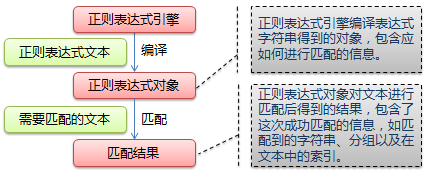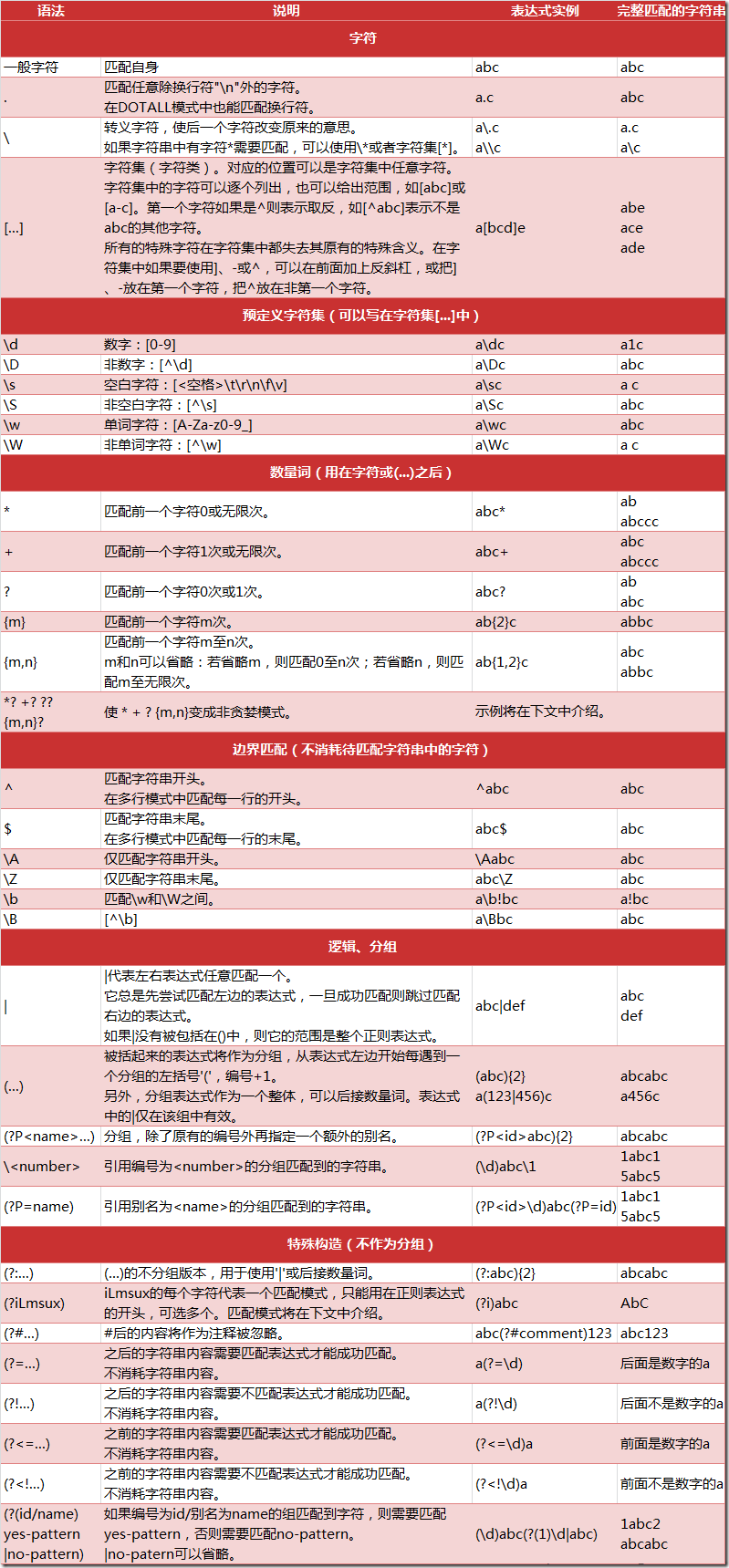網路爬蟲(六):Python中的正則表示式教程
但是在這之前,先詳細的整理一下Python中的正則表示式的相關內容。
正則表示式在Python爬蟲中的作用就像是老師點名時用的花名冊一樣,是必不可少的神兵利器。
整理時沒有注意,實在抱歉。
一、 正則表示式基礎
1.1.概念介紹
正則表示式是用於處理字串的強大工具,它並不是Python的一部分。
其他程式語言中也有正則表示式的概念,區別只在於不同的程式語言實現支援的語法數量不同。
它擁有自己獨特的語法以及一個獨立的處理引擎,在提供了正則表示式的語言裡,正則表示式的語法都是一樣的。
下圖展示了使用正則表示式進行匹配的流程:
正則表示式的大致匹配過程是:
1.依次拿出表示式和文字中的字元比較,
2.如果每一個字元都能匹配,則匹配成功;一旦有匹配不成功的字元則匹配失敗。
3.如果表示式中有量詞或邊界,這個過程會稍微有一些不同。
下圖列出了Python支援的正則表示式元字元和語法:
1.2. 數量詞的貪婪模式與非貪婪模式
正則表示式通常用於在文字中查詢匹配的字串。
貪婪模式,總是嘗試匹配儘可能多的字元;
非貪婪模式則相反,總是嘗試匹配儘可能少的字元。
Python裡數量詞預設是貪婪的。
例如:正則表示式"ab*"如果用於查詢"abbbc",將找到"abbb"。
而如果使用非貪婪的數量詞"ab*?",將找到"a"。
1.3. 反斜槓的問題
與大多數程式語言相同,正則表示式裡使用"\"作為轉義字元,這就可能造成反斜槓困擾。
假如你需要匹配文字中的字元"\",那麼使用程式語言表示的正則表示式裡將需要4個反斜槓"\\\\":
第一個和第三個用於在程式語言裡將第二個和第四個轉義成反斜槓,
轉換成兩個反斜槓\\後再在正則表示式裡轉義成一個反斜槓用來匹配反斜槓\。
這樣顯然是非常麻煩的。
Python裡的原生字串很好地解決了這個問題,這個例子中的正則表示式可以使用r"\\"表示。
同樣,匹配一個數字的"\\d"可以寫成r"\d"。
有了原生字串,媽媽再也不用擔心我的反斜槓問題~
二、 介紹re模組
2.1. Compile
Python通過re模組提供對正則表示式的支援。
使用re的一般步驟是:
Step1:先將正則表示式的字串形式編譯為Pattern例項。
Step2:然後使用Pattern例項處理文字並獲得匹配結果(一個Match例項)。
Step3:最後使用Match例項獲得資訊,進行其他的操作。
我們新建一個re01.py來試驗一下re的應用:
# -*- coding: utf-8 -*-
#一個簡單的re例項,匹配字串中的hello字串
#匯入re模組
import re
# 將正則表示式編譯成Pattern物件,注意hello前面的r的意思是“原生字串”
pattern = re.compile(r'hello')
# 使用Pattern匹配文字,獲得匹配結果,無法匹配時將返回None
match1 = pattern.match('hello world!')
match2 = pattern.match('helloo world!')
match3 = pattern.match('helllo world!')
#如果match1匹配成功
if match1:
# 使用Match獲得分組資訊
print match1.group()
else:
print 'match1匹配失敗!'
#如果match2匹配成功
if match2:
# 使用Match獲得分組資訊
print match2.group()
else:
print 'match2匹配失敗!'
#如果match3匹配成功
if match3:
# 使用Match獲得分組資訊
print match3.group()
else:
print 'match3匹配失敗!'可以看到控制檯輸出了匹配的三個結果:
下面來具體看看程式碼中的關鍵方法。
★ re.compile(strPattern[, flag]):
這個方法是Pattern類的工廠方法,用於將字串形式的正則表示式編譯為Pattern物件。
第二個引數flag是匹配模式,取值可以使用按位或運算子'|'表示同時生效,比如re.I | re.M。
另外,你也可以在regex字串中指定模式,
比如re.compile('pattern', re.I | re.M)與re.compile('(?im)pattern')是等價的。
可選值有:
- re.I(全拼:IGNORECASE): 忽略大小寫(括號內是完整寫法,下同)
- re.M(全拼:MULTILINE): 多行模式,改變'^'和'$'的行為(參見上圖)
- re.S(全拼:DOTALL): 點任意匹配模式,改變'.'的行為
- re.L(全拼:LOCALE): 使預定字元類 \w \W \b \B \s \S 取決於當前區域設定
- re.U(全拼:UNICODE): 使預定字元類 \w \W \b \B \s \S \d \D 取決於unicode定義的字元屬性
- re.X(全拼:VERBOSE): 詳細模式。這個模式下正則表示式可以是多行,忽略空白字元,並可以加入註釋。
以下兩個正則表示式是等價的:
# -*- coding: utf-8 -*-
#兩個等價的re匹配,匹配一個小數
import re
a = re.compile(r"""\d + # the integral part
\. # the decimal point
\d * # some fractional digits""", re.X)
b = re.compile(r"\d+\.\d*")
match11 = a.match('3.1415')
match12 = a.match('33')
match21 = b.match('3.1415')
match22 = b.match('33')
if match11:
# 使用Match獲得分組資訊
print match11.group()
else:
print u'match11不是小數'
if match12:
# 使用Match獲得分組資訊
print match12.group()
else:
print u'match12不是小數'
if match21:
# 使用Match獲得分組資訊
print match21.group()
else:
print u'match21不是小數'
if match22:
# 使用Match獲得分組資訊
print match22.group()
else:
print u'match22不是小數' re提供了眾多模組方法用於完成正則表示式的功能。
這些方法可以使用Pattern例項的相應方法替代,唯一的好處是少寫一行re.compile()程式碼,
但同時也無法複用編譯後的Pattern物件。
這些方法將在Pattern類的例項方法部分一起介紹。
如一開始的hello例項可以簡寫為:
# -*- coding: utf-8 -*-
#一個簡單的re例項,匹配字串中的hello字串
import re
m = re.match(r'hello', 'hello world!')
print m.group() re模組還提供了一個方法escape(string),用於將string中的正則表示式元字元如*/+/?等之前加上轉義符再返回
2.2. Match
Match物件是一次匹配的結果,包含了很多關於此次匹配的資訊,可以使用Match提供的可讀屬性或方法來獲取這些資訊。
屬性:
- string: 匹配時使用的文字。
- re: 匹配時使用的Pattern物件。
- pos: 文字中正則表示式開始搜尋的索引。值與Pattern.match()和Pattern.seach()方法的同名引數相同。
- endpos: 文字中正則表示式結束搜尋的索引。值與Pattern.match()和Pattern.seach()方法的同名引數相同。
- lastindex: 最後一個被捕獲的分組在文字中的索引。如果沒有被捕獲的分組,將為None。
- lastgroup: 最後一個被捕獲的分組的別名。如果這個分組沒有別名或者沒有被捕獲的分組,將為None。
方法:
- group([group1, …]):
獲得一個或多個分組截獲的字串;指定多個引數時將以元組形式返回。group1可以使用編號也可以使用別名;編號0代表整個匹配的子串;不填寫引數時,返回group(0);沒有截獲字串的組返回None;截獲了多次的組返回最後一次截獲的子串。 - groups([default]):
以元組形式返回全部分組截獲的字串。相當於呼叫group(1,2,…last)。default表示沒有截獲字串的組以這個值替代,預設為None。 - groupdict([default]):
返回以有別名的組的別名為鍵、以該組截獲的子串為值的字典,沒有別名的組不包含在內。default含義同上。 - start([group]):
返回指定的組截獲的子串在string中的起始索引(子串第一個字元的索引)。group預設值為0。 - end([group]):
返回指定的組截獲的子串在string中的結束索引(子串最後一個字元的索引+1)。group預設值為0。 - span([group]):
返回(start(group), end(group))。 - expand(template):
將匹配到的分組代入template中然後返回。template中可以使用\id或\g<id>、\g<name>引用分組,但不能使用編號0。\id與\g<id>是等價的;但\10將被認為是第10個分組,如果你想表達\1之後是字元'0',只能使用\g<1>0。
下面來用一個py例項輸出所有的內容加深理解:
# -*- coding: utf-8 -*-
#一個簡單的match例項
import re
# 匹配如下內容:單詞+空格+單詞+任意字元
m = re.match(r'(\w+) (\w+)(?P<sign>.*)', 'hello world!')
print "m.string:", m.string
print "m.re:", m.re
print "m.pos:", m.pos
print "m.endpos:", m.endpos
print "m.lastindex:", m.lastindex
print "m.lastgroup:", m.lastgroup
print "m.group():", m.group()
print "m.group(1,2):", m.group(1, 2)
print "m.groups():", m.groups()
print "m.groupdict():", m.groupdict()
print "m.start(2):", m.start(2)
print "m.end(2):", m.end(2)
print "m.span(2):", m.span(2)
print r"m.expand(r'\g<2> \g<1>\g<3>'):", m.expand(r'\2 \1\3')
### output ###
# m.string: hello world!
# m.re: <_sre.SRE_Pattern object at 0x016E1A38>
# m.pos: 0
# m.endpos: 12
# m.lastindex: 3
# m.lastgroup: sign
# m.group(1,2): ('hello', 'world')
# m.groups(): ('hello', 'world', '!')
# m.groupdict(): {'sign': '!'}
# m.start(2): 6
# m.end(2): 11
# m.span(2): (6, 11)
# m.expand(r'\2 \1\3'): world hello! 2.3. Pattern
Pattern物件是一個編譯好的正則表示式,通過Pattern提供的一系列方法可以對文字進行匹配查詢。
Pattern不能直接例項化,必須使用re.compile()進行構造,也就是re.compile()返回的物件。
Pattern提供了幾個可讀屬性用於獲取表示式的相關資訊:
- pattern: 編譯時用的表示式字串。
- flags: 編譯時用的匹配模式。數字形式。
- groups: 表示式中分組的數量。
- groupindex: 以表示式中有別名的組的別名為鍵、以該組對應的編號為值的字典,沒有別名的組不包含在內。
可以用下面這個例子檢視pattern的屬性:
# -*- coding: utf-8 -*-
#一個簡單的pattern例項
import re
p = re.compile(r'(\w+) (\w+)(?P<sign>.*)', re.DOTALL)
print "p.pattern:", p.pattern
print "p.flags:", p.flags
print "p.groups:", p.groups
print "p.groupindex:", p.groupindex
### output ###
# p.pattern: (\w+) (\w+)(?P<sign>.*)
# p.flags: 16
# p.groups: 3
# p.groupindex: {'sign': 3}
下面重點介紹一下pattern的例項方法及其使用。
1.match
match(string[, pos[, endpos]]) | re.match(pattern, string[, flags]):
這個方法將從string的pos下標處起嘗試匹配pattern;
如果pattern結束時仍可匹配,則返回一個Match物件;
如果匹配過程中pattern無法匹配,或者匹配未結束就已到達endpos,則返回None。
pos和endpos的預設值分別為0和len(string);
re.match()無法指定這兩個引數,引數flags用於編譯pattern時指定匹配模式。
注意:這個方法並不是完全匹配。
當pattern結束時若string還有剩餘字元,仍然視為成功。
想要完全匹配,可以在表示式末尾加上邊界匹配符'$'。
下面來看一個Match的簡單案例:
# encoding: UTF-8
import re
# 將正則表示式編譯成Pattern物件
pattern = re.compile(r'hello')
# 使用Pattern匹配文字,獲得匹配結果,無法匹配時將返回None
match = pattern.match('hello world!')
if match:
# 使用Match獲得分組資訊
print match.group()
### 輸出 ###
# hello 2.search
search(string[, pos[, endpos]]) | re.search(pattern, string[, flags]): 這個方法用於查詢字串中可以匹配成功的子串。從string的pos下標處起嘗試匹配pattern,
如果pattern結束時仍可匹配,則返回一個Match物件;
若無法匹配,則將pos加1後重新嘗試匹配;
直到pos=endpos時仍無法匹配則返回None。
pos和endpos的預設值分別為0和len(string));
re.search()無法指定這兩個引數,引數flags用於編譯pattern時指定匹配模式。
那麼它和match有什麼區別呢?
match()函式只檢測re是不是在string的開始位置匹配,
search()會掃描整個string查詢匹配,
match()只有在0位置匹配成功的話才有返回,如果不是開始位置匹配成功的話,match()就返回none
例如:
print(re.match(‘super’, ‘superstition’).span())
會返回(0, 5)
print(re.match(‘super’, ‘insuperable’))
則返回None
search()會掃描整個字串並返回第一個成功的匹配
例如:
print(re.search(‘super’, ‘superstition’).span())
返回(0, 5)
print(re.search(‘super’, ‘insuperable’).span())
返回(2, 7)
看一個search的例項:
# -*- coding: utf-8 -*-
#一個簡單的search例項
import re
# 將正則表示式編譯成Pattern物件
pattern = re.compile(r'world')
# 使用search()查詢匹配的子串,不存在能匹配的子串時將返回None
# 這個例子中使用match()無法成功匹配
match = pattern.search('hello world!')
if match:
# 使用Match獲得分組資訊
print match.group()
### 輸出 ###
# world 3.split
split(string[, maxsplit]) | re.split(pattern, string[, maxsplit]):按照能夠匹配的子串將string分割後返回列表。
maxsplit用於指定最大分割次數,不指定將全部分割。
import re
p = re.compile(r'\d+')
print p.split('one1two2three3four4')
### output ###
# ['one', 'two', 'three', 'four', ''] 4.findall
findall(string[, pos[, endpos]]) | re.findall(pattern, string[, flags]):搜尋string,以列表形式返回全部能匹配的子串。
import re
p = re.compile(r'\d+')
print p.findall('one1two2three3four4')
### output ###
# ['1', '2', '3', '4'] 5.finditer
finditer(string[, pos[, endpos]]) | re.finditer(pattern, string[, flags]):搜尋string,返回一個順序訪問每一個匹配結果(Match物件)的迭代器。
import re
p = re.compile(r'\d+')
for m in p.finditer('one1two2three3four4'):
print m.group(),
### output ###
# 1 2 3 4 6.sub
sub(repl, string[, count]) | re.sub(pattern, repl, string[, count]):使用repl替換string中每一個匹配的子串後返回替換後的字串。
當repl是一個字串時,可以使用\id或\g<id>、\g<name>引用分組,但不能使用編號0。
當repl是一個方法時,這個方法應當只接受一個引數(Match物件),並返回一個字串用於替換(返回的字串中不能再引用分組)。
count用於指定最多替換次數,不指定時全部替換。
import re
p = re.compile(r'(\w+) (\w+)')
s = 'i say, hello world!'
print p.sub(r'\2 \1', s)
def func(m):
return m.group(1).title() + ' ' + m.group(2).title()
print p.sub(func, s)
### output ###
# say i, world hello!
# I Say, Hello World! 7.subn
subn(repl, string[, count]) |re.sub(pattern, repl, string[, count]):返回 (sub(repl, string[, count]), 替換次數)。
import re
p = re.compile(r'(\w+) (\w+)')
s = 'i say, hello world!'
print p.subn(r'\2 \1', s)
def func(m):
return m.group(1).title() + ' ' + m.group(2).title()
print p.subn(func, s)
### output ###
# ('say i, world hello!', 2)
# ('I Say, Hello World!', 2) 至此,Python的正則表示式基本介紹就算是完成了^_^
原文連結:http://blog.csdn.net/pleasecallmewhy/article/details/8929576



